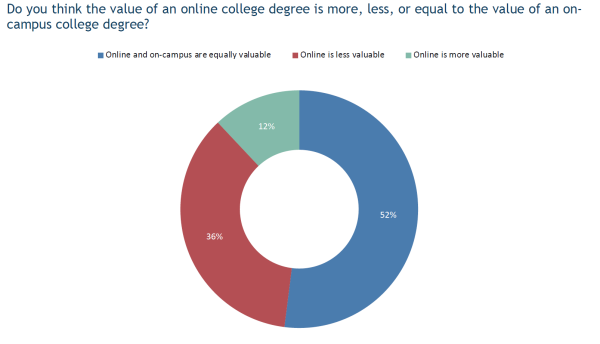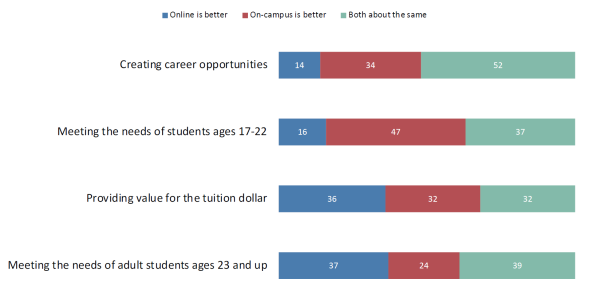You have /5 articles left.
Sign up for a free account or log in.

Seventy-three percent of adults thought online education was as good as in-person or better at meeting the needs of traditional students; up from 40 percent who believed that in 2017, according to a new survey.
Getty Images
Nearly half of Americans have developed a better opinion of online education since the COVID-19 pandemic, with a growing number of young students flocking to the virtual classroom, according to a new report.
Champlain College Online released a survey Thursday diving into the perception of online education, from its value to employers’ acceptance of online degrees.
Champlain officials previously released a report on the topic in 2017. After the pandemic began in 2020, when institutions were forced to adapt to online learning regardless of previous opinions on the modality, the college’s leaders thought a report update was warranted.
“We decided the world’s changed so dramatically, it was time to revisit and see what perceptions were,” said Chris Montagnino, vice president at Champlain Online.
The study collected replies from roughly 2,000 respondents in July 2023. They ranged in age from 18 to 55, with 45 percent of them holding at least a bachelor’s degree, 19 percent having at least some college experience and 27 percent being high school graduates.
The overall perception of online learning has drastically shifted since 2017, according to the report. Nearly three-fourths (72 percent) of respondents said it was a more reputable way to get an online degree now than five years ago. The biggest perceptual change appeared to occur among the Gen Z population: when asked if they had a better or worse opinion of online education than five years ago, 47 percent said their opinion improved, compared to millennials with 42 percent and Gen X with 38 percent.
The changed perception among younger learners was one of the more important takeaways for Montagnino.
“We’ve always geared [Champlain Online’s efforts] toward the working student, but we’re seeing the continual increase of interest and support for those under 23,” she said, adding that other fully online institutions such as Southern New Hampshire University and the University of Phoenix have seen the same. “No one is marketing to them, but we’re seeing younger and younger students.”
The reasoning behind the continued increase was not unpacked in the report, but Montagnino said she had a few theories about the influx of young students. It could be due to continuing economic hardships, with many families unable to afford more traditional routes; the introduction of virtual learning during the COVID-19 pandemic, when many of the students were in high school; and the continuing student debt crisis, which has caused some to re-evaluate the value of a traditional institution.
Numerous other data points in the survey suggested increased acceptance of online learning. Among them:
- Seventy-three percent of adults thought online education was the same or better at meeting the needs of traditional students, up from 40 percent who believed that in 2017.
- There was a 20-percentage-point jump from 2017 to 2023, to 84 percent, in the proportion of respondents asked if online institutions were the same or better at meeting the needs of adult students.
- Eighty-four percent believe employers are more accepting of online degrees today than they were pre-pandemic.
- About 80 percent stated they would consider an online program if they were enrolling in an undergraduate or post graduate program.
- Nearly six in 10 (58 percent) understood there is a difference between online education and remote learning, with 42 percent stating there is no difference.
While many of the results showed greater acceptance of and respect for online learning, some revealed continuing questions about the validity and value of virtual education.
Only about half (52 percent) of respondents, for instance, said online programs are equally as valuable as their on-campus counterparts, with 36 percent saying online programs are less valuable and 12 percent believing online is more valuable than on-campus programs. That number ticked up slightly when respondents were asked about online master’s programs, with 54 percent stating they are equal.

Respondents recognized that different delivery modes serve different student populations. Thirty-seven percent said they believe online programming is best at meeting the needs of adult students, while 47 percent believe on-campus is best for meeting the needs of students 17 to 22 years old. Half of respondents (52 percent) believe on-campus and online provide the same variety of career opportunities.

When it comes to the value of the dollar for different delivery modes, the sample was roughly equally split: 36 percent believe online is the best value, 32 percent said on-campus is best and 32 percent said they provide roughly the same value.
Montagnino said she believes while public perception of online education will continue to improve, it will also be impacted by another disrupter: artificial intelligence.
“This is going to revolutionize not only higher education but employment in general,” she said. “AI probably ranks up there—besides the pandemic—as a dramatic change to higher ed.”









